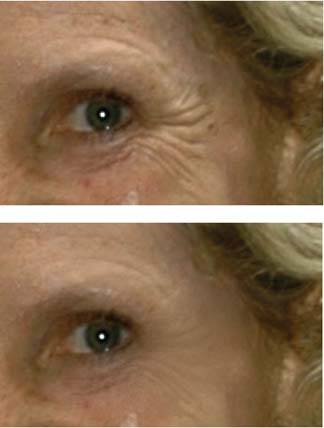Section 8.6. Painting Over Freckles, Scratches, and Hairs
8.6. Painting Over Freckles, Scratches, and HairsSometimes an otherwise perfect portrait is spoiled by the tiniest of imperfectionsa stray hair or an unsightly blemish, for example. Professional photographers, whether working digitally or in a traditional darkroom, routinely remove such minor imperfections from their final printsa process known as retouching , for clients known as self-conscious . iPhoto's Retouch brush lets you do the same thing with your own digital photos. You can paint away scratches, spots, hairs, or any other small flaws in your photos with a few quick strokes.
The operative word here is small . The Retouch brush can't wipe out a big blob of spaghetti sauce on your son's white shirt or completely erase somebody's mustache . It's intended for tiny fixups that don't involve repainting whole sections of a photo. (For that kind of photo overhaul , you need a dedicated photo-editing program.) The Retouch brush works its magic by blending together the colors in the tiny area that you're fixing. It doesn't cover the imperfections you're trying to remove, but blurs them out by softly blending them into a small radius of surrounding pixels. You can see the effect in Figure 8-4. Tip: The Retouch brush is particularly useful if your photo library contains traditional photographs that you've scanned in. You can use it to wipe away the dust specks and scratches that often appear on film negatives and prints, or those that are introduced when you scan the photos.
8.6.1. Using the Retouch BrushThe Retouch brush appears at the bottom of the window as soon as you open a photo for editing. You can also switch to it whenever you're in Editing mode, by Controlclicking a photo and choosing Retouch from the shortcut menu. Once you've selected the Retouch brush, your pointer turns into a small crosshair with a hole in the middle. Using the center of the crosshair, target the imperfection and "paint" over it, using a series of short strokes to blend it with the surrounding portion of the picture. Don't overdo it: If you apply too much retouching, the area you're working on starts to look noticeably blurry and unnatural , as if someone smeared Vaseline on it. Fortunately, you can use the Edit Note: On high-resolution photos, it can take a moment or two for iPhoto to process each individual stroke of the Retouch brush. If you don't see any results, wait a second for iPhoto to catch up with you. |
EAN: 2147483647
Pages: 314

 Undo command ( -Z) to take back as many of your brush strokes as necessary.
Undo command ( -Z) to take back as many of your brush strokes as necessary.